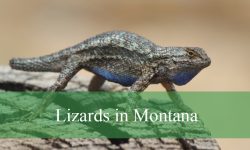The diverse landscape of New Mexico hosts a rich array of moth species. From the impressive Polyphemus Moth with its striking eyespots to the unassuming yet adaptable Green Cloverworm Moth, these creatures play essential roles in the ecosystem. Delicate beauties like the Pale Beauty and the intricate patterns of the Salt Marsh Moth add to the state’s natural charm. With a variety of habitats and lifecycles, the moths of New Mexico continue to captivate researchers and nature enthusiasts alike.
This article compiles 25 common moth species in New Mexico, along with images and how to identify them.
American Dagger

The American Dagger (Acronicta americana) is a sizable dagger moth in New Mexico. With wingspans ranging from 2 to 2.6 inches (5-6.6 cm), they flaunt intricate black and white patterns featuring zig-zags, checkerboards, and lines. Their name stems from the dagger-shaped markings on their forewings. These moths prefer deciduous habitats like forests, parks, and backyards, where their caterpillars thrive from July to October.
Ailanthus Webworm Moth
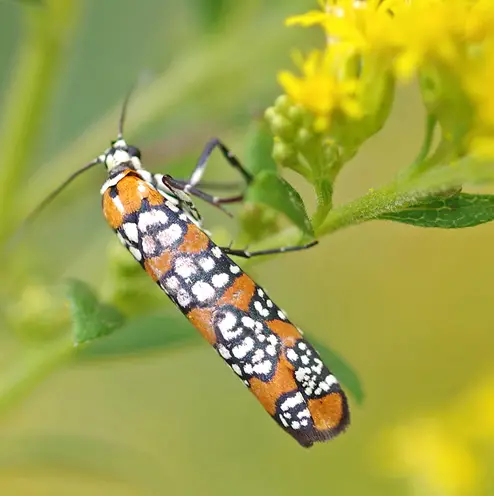
The Ailanthus Webworm Moth (Atteva aurea) showcases orange forewings adorned with four bands of yellow spots outlined in black, with hindwings of solid smoky gray. In New Mexico, variations exist, such as smaller yellow spots in southern areas. Known for their rapid life cycle, they transition from egg to adult within four weeks. These moths pollinate by feeding on nectar, utilizing chemicals from their tree-of-heaven diet to deter predators.
Fall Webworm Moth
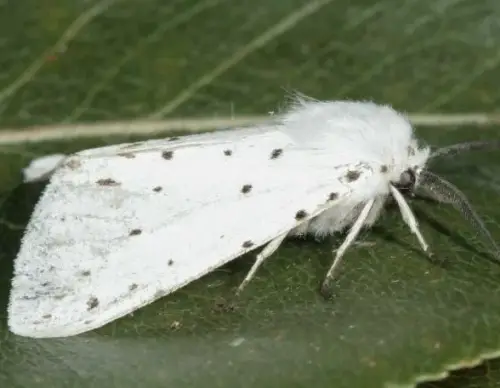
The Fall Webworm Moth (Hyphantria cunea) boasts a wingspan of 1.4 to 1.7 inches (3.5-4.3 cm) with predominantly white forewings adorned with gray or black rectangular spots. Their caterpillars, known to feed on over 100 hardwood tree species, construct protective tents around leaves, providing shelter and protection from predators. In New Mexico, they’re visible between April and September, with regional variations in brood numbers.
Yellow-collared Scape Moth
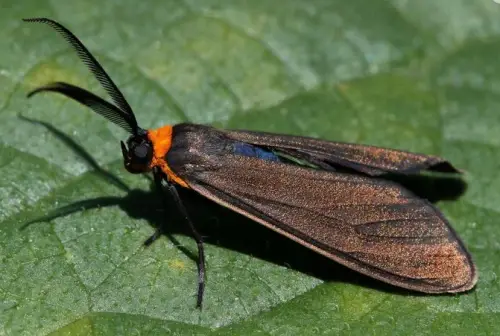
The Yellow-collared Scape Moth (Cisseps fulvicollis) is prevalent in New Mexico, sporting black forewings and bodies with an orange or yellow collar. Thriving in wet meadows, parks, and forest edges, they are active during the day, serving as proficient pollinators for various flowers like milkweed, asters, and goldenrod. Their wasp-mimicry coloring deters predators while foraging, and they can have one to three generations per breeding season, overwintering as immature caterpillars.
Isabella Tiger Moth
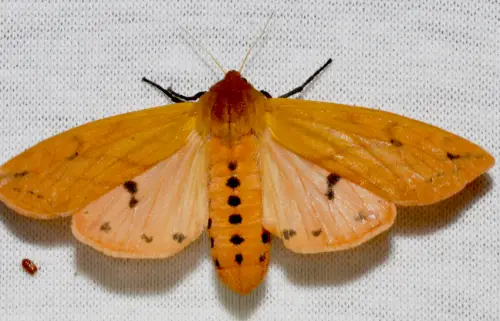
The Isabella Tiger Moth (Pyrrharctia Isabella) exhibits a wingspan of 1.75 to 2.5 inches (4-6 cm) and features orange-yellow to yellowish-brown coloring with sparse black spotting, accompanied by a line of black spots down the abdomen and bright orange forelegs. They adapt to various habitats in New Mexico, even surviving in the Arctic through unique cryoprotectant production during their dormant stage. This adaptation aids their survival during frigid winters, allowing them to thaw out and resume their lifecycle in the spring.
Virginian Tiger Moth
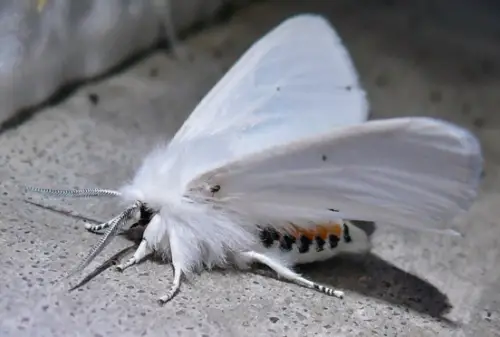
The Virginian Tiger Moth (Spilosoma virginica) boasts a wingspan of 1.25 to 2 inches (3-5 cm) with pure white wings adorned by a few black dots, while their abdomens display white with yellow stripes and rows of black dots, with males possessing large, feathery antennae. In New Mexico, they inhabit a variety of habitats, including hardwood forests, rainforests, and urban areas, often seen around outdoor light sources. To find mates, they utilize unique communication methods, with females emitting pheromones and males navigating with their specialized antennae. They tend to have multiple broods yearly, with the last brood overwintering as caterpillars.
Milkweed Tussock Moth
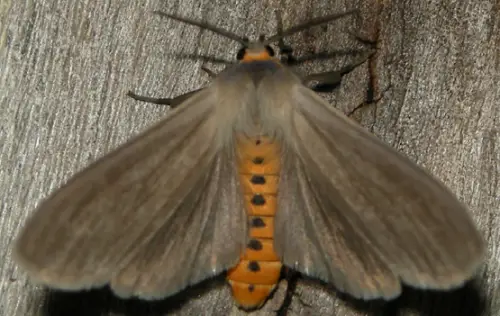
The Milkweed Tussock Moth (Euchaetes egle) features a wingspan of 1.25 to 1.7 inches (3-4.3 cm) and presents a mousy gray hue with a yellow abdomen donning rows of black spots. While their adult form appears unremarkable, their caterpillars are adorned with striking tufts of black, white, orange, and sometimes yellow hairs. Employing chemical defense mechanisms against predators, they emit high-frequency clicks from their tymbal organ to warn of their toxicity, ensuring their survival. These moths often coexist with Monarch butterflies, both benefiting from milkweed plants without harming them.
Polyphemus Moth
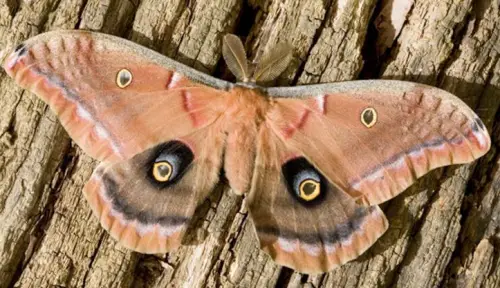
The Polyphemus Moth (Antheraea polyphemus) boasts a 4 to 6-inch (10-15 cm) wingspan, featuring reddish-brown, gray, or yellow-brown upper wings with striking, large yellow eyespots rimmed in blue. Their intimidating eyespot pattern mimics a great horned owl’s face, effectively deterring predators. In New Mexico, they inhabit various areas, including forests, orchards, and wetlands, but live only about four days as adults, prioritizing reproduction over sustenance.
Green Cloverworm Moth

The Green Cloverworm Moth (Hypena scabra) showcases a modest 0.98 to 1.38-inch (2.5-3.5 cm) wingspan, with narrow forewings in yellow, tan, or orange, accentuated by a central black line. Common around outdoor lights, they reside in gardens, fields, and woodland edges, although their larval stage can pose a threat to vegetables, warranting caution for gardeners. With multiple yearly broods, they can be spotted throughout the year in warmer regions and between March and November in northern climates, occasionally even on atypical warm days.
Io Moth
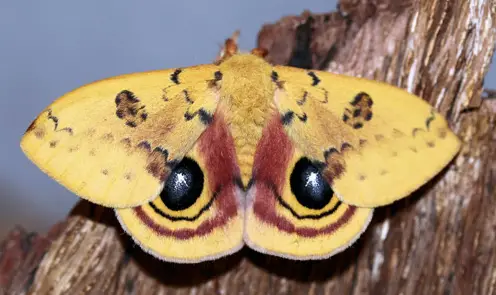
The Io Moth (Automeris io) with 2.5 to 3.5-inch (6-8.9 cm) wingspans features striking colors and a large eyespot on each hindwing. In New Mexico, they startle predators and observers alike by revealing these eyespots when threatened. Active from May to June in northern areas, they produce two to three broods in warmer southern regions, with sightings from February to September. Despite their captivating appearance, their caterpillars bear venomous spines and move in distinctive trains, making them a captivating yet cautious sight.
Salt Marsh Moth
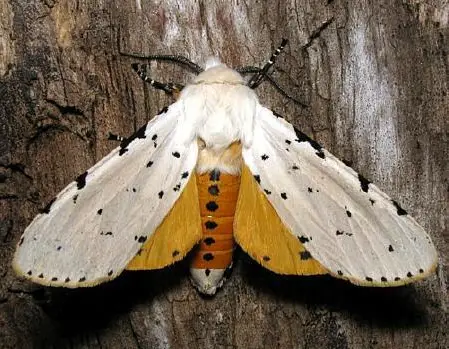
The Salt Marsh Moth (Estigmene acrea) with 1.75 to 2.69-inch (4.4-6.8 cm) wingspans, has a notorious reputation as an agricultural pest in New Mexico. Their caterpillars consume various crops, necessitating protective measures for corn, tomatoes, cotton, and numerous other plants. Active from May to August, they produce one to four broods per year, depending on their location. Remarkably, their caterpillars employ a unique defense mechanism, using silk strands as a parachute to evade threats, earning them the nickname “windsurfers.”
Southern Flannel Moth
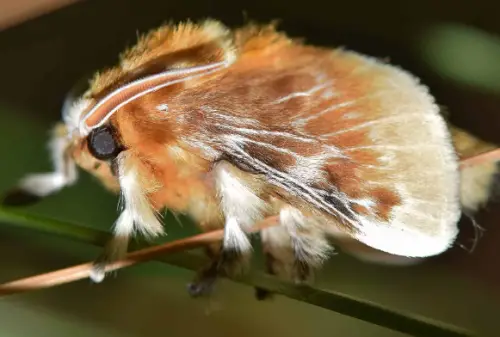
The Southern Flannel Moth (Megalopyge opercularis), known for its furry appearance, possesses a venomous caterpillar stage. Recognized as the Puss Caterpillar, its deceptive fur contains spines causing intense pain upon contact with human skin. Be cautious in deciduous forests and adjacent areas, as encounters are common in backyards, playgrounds, and parks. Handle with care while handling brush or maintaining your yard to avoid any painful incidents.
White-lined Sphinx
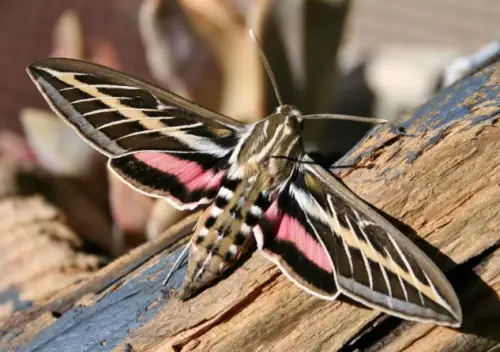
The White-lined Sphinx (Hyles lineata) Moth, often mistaken for hummingbirds, hovers to sip nectar from various flowers using their long proboscis. Their preferred flowers include Cardinal Vine, Petunia, and Lilac. During spring, females lay numerous eggs, occasionally leading to massive caterpillar migrations, with reports of them covering entire road sections. Their pupation occurs underground, lasting around two to three weeks before their emergence as adult moths.
Carolina Sphinx
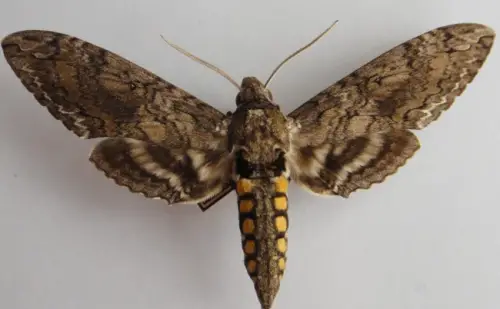
The Carolina Sphinx (Manduca sexta) Moth, recognized for its large size and hovering abilities, serves as an effective pollinator, drawn to various flowers and tubular blossoms rich in nectar. However, its caterpillar stage, known as the Tobacco Hornworm, poses a threat to crops like tomatoes, potatoes, and peppers. While active year-round in warmer regions, they only appear between May and October in cooler areas, with multiple broods possible in southern regions. After selecting a pupation site, they may overwinter before emerging as adult moths, capable of laying up to 1,000 eggs.
Large Yellow Underwing
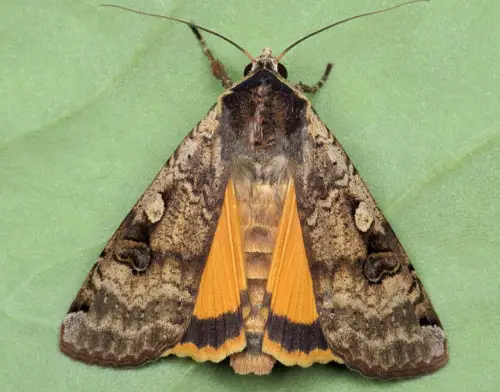
The Large Yellow Underwing (Noctua pronuba) in New Mexico, with a wingspan of 1.57 to 2.36 inches (4-6 cm), startles predators with their vibrant hindwings during takeoff. Thriving in diverse habitats such as open areas, urban spaces, and parks, they’re primarily nocturnal and drawn to outdoor lights. Unlike other species, they have a relatively long lifespan, averaging 55 days for males and 75 days for females, yet only produce one generation per year.
Spotted Tussock Moth
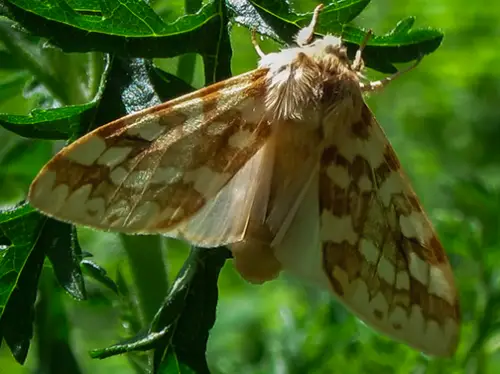
The Spotted Tussock Moth (Lophocampa maculata) exhibits a 1.38 to 1.69-inch (3.5-4.3 cm) wingspan, distinguished by yellow or tan forewings and a cream-colored furry body. Flourishing in deciduous forests, they display polymorphic characteristics, resulting in various color variations. These moths and their caterpillars exhibit specific regional preferences for tree species, indicating a diverse culinary inclination. After a two-month feeding period, the caterpillars pupate within brown silk cocoons attached to leaves, overwintering and emerging as adults the following spring.
Alfalfa Looper
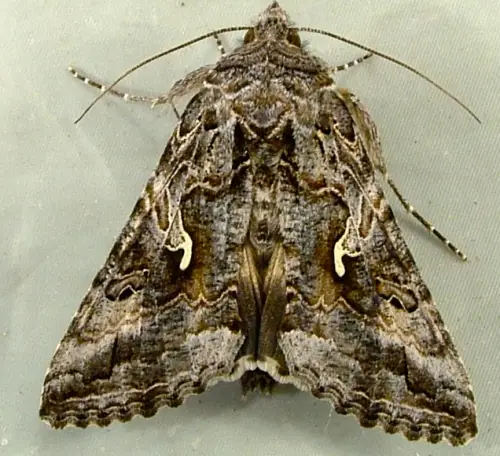
The Alfalfa Looper (Autographa californica) in New Mexico, boasting a 1.42 to 1.65-inch (3.6-4.2 cm) wingspan, cleverly blends into open habitats with its mottled gray appearance. Active day and night, they feed on nectar from low-growing plants and are often visible around outdoor lights. With multiple yearly broods, their activity spans from February to November in southern areas and May to October in the north. Remarkably, their entire life cycle, from hatching to death, can last a mere 30 days.
Pandora Pinemoth
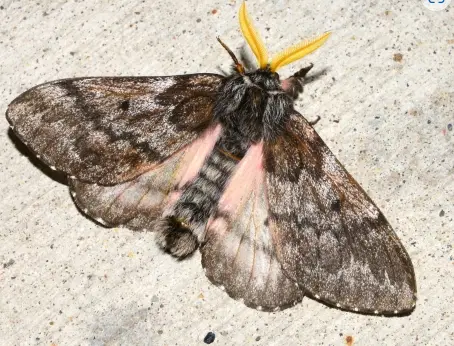
The Pandora Pinemoth (Coloradia pandora) in New Mexico, with a 3.25 to 3.88-inch (8.3-9.9 cm) wingspan, exhibits a selective diet, primarily feeding on pine trees and occasionally Douglas Firs. Often found in Ponderosa Pine forests, they venture into neighboring areas during population booms. Requiring a two-year lifecycle, females lay approximately 80 eggs on pine needles or bark, with hatching taking 40 to 50 days. After overwintering, caterpillars resume feeding in spring, rapidly growing until maturation in July or August. Pupation occurs in the soil, lasting one to five years, leading to population booms every 20 to 30 years, lasting six to eight years.
Police Car Moth
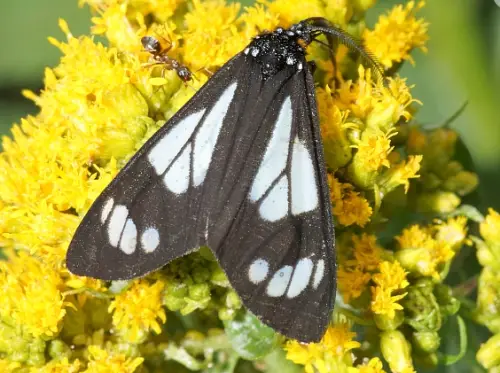
The Police Car Moth (Gnophaela vermiculata) in New Mexico, averaging a 2-inch (5 cm) wingspan, displays striking black wings with large white patches outlined by black veins. Their black bodies, adorned with white spots and bright orange accents, serve as a warning to predators. Synthesizing toxic chemicals and utilizing a tymbal organ to produce ultrasonic clicks, they successfully evade predators during both day and night. With just one brood annually, females deposit eggs on leaves, hatching within a short seven days and overwintering as caterpillars before pupating the following season.
Western Tent Caterpillar Moth

The Western Tent Caterpillar Moth (Malacosoma californica) in New Mexico, with a 1 to 2-inch (2.5-5 cm) wingspan, lays 150 to 250 eggs in oval masses covered with spumaline to retain heat and moisture, safeguarding against predators. Despite maturing in a short three to four weeks, caterpillars overwinter within silken tents for protection. During population outbreaks, they can swiftly defoliate trees, although the trees typically recover. Their preferred tree species vary regionally, depending on their location.
Forest Tent Caterpillar Moth
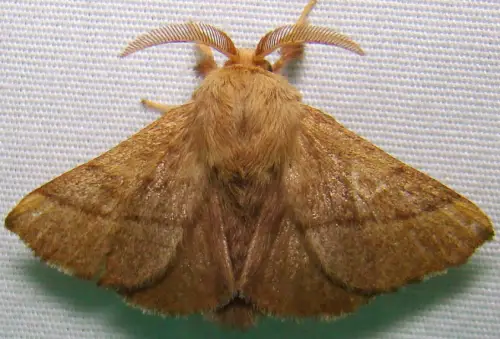
The Forest Tent Caterpillar Moth (Malacosoma disstria) in New Mexico boasts a 1 to 1.75-inch (2.5-4.4 cm) wingspan, exhibiting yellow, tan, or buff-brown wings with parallel darker lines. Their population fluctuates in cyclical patterns, with outbreaks occurring every 6-16 years, lasting 4-6 years. Unlike their counterparts, they do not spin true tents but construct silk mats on tree trunks or branches for resting between feedings.
Pale Beauty Moth

Pale Beauty moths (Campaea perlata) in New Mexico boast 1.1-2 inch (2.8-5 cm) wingspans and a distinctive pale green to grayish-white color, sometimes transitioning to yellow with age. Their presence is prominent from late spring to early autumn, with an affinity for outdoor lights. These moths primarily reside in deciduous woodlands, overwintering as caterpillars and pupating before spring emerges.
People Who Read This Also Read:



